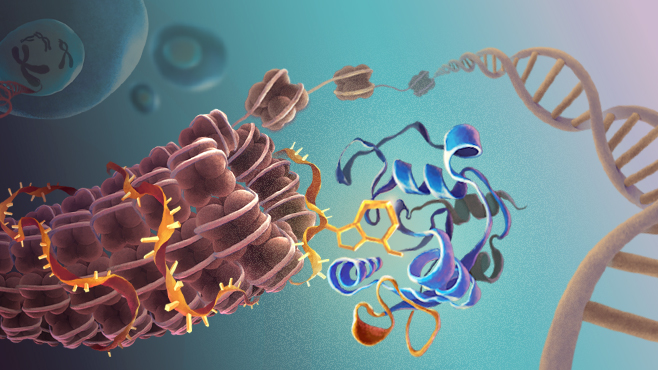In a study published in Nature, a research group led by CHEN Jiekai from Guangzhou Institute of Biomedicine and Health of the Chinese Academy of Sciences discovered that RNA m6A reader YT521-B homology-domain-containing protein 1 (YTHDC1) governs the formation of H3K9me3-assciated heterochromatin.
The researchers identified that depletion of either Ythdc1 or Mettl3 reactivated the H3K9me3-deposited retrotransposons, accompanied by a pronounced reduction of SETDB1-mediated H3K9me3 and induced transition of the 2C-like state. The identification of YTHDC1 as a novel regulator of m6A-scaffoled chromatin silencing demonstrates that retrotransposon RNA enables the recruitment of SETDB1 to the targeted chromatin via m6A-YTHDC1, contributing to cell fate regulation.
N6-methyladenosine (m6A) is the most abundant modification on RNA molecules present in eukaryotes, and recognized byYTH-domain containing readers.
Among five YTH family m6A readers, nuclear reader YTHDC1 is the sole protein leading to early embryonic lethality upon deletion in mice, resembling the phenotype of Mettle3, an m6A transferase, knockout (KO). By contrast, mice deficient in other YTH readers including Ythdf1-3 or known YTHDC1-interacting genes such as Zcchc8 survive at the early embryonic stage, suggesting m6A has unidentified role besides post-transcriptional regulation.
The formation of H3K9me3-associated heterochromatin is a prominent mechanism in cell fate determination. H3K9me3 predominantly labels and represses the retrotransposon regions across the genome in mouse embryonic stem (ES) cells, in addition to the constitutive heterochromatin including centromere and telomere. SETDB1 catalyzes retrotransposon H3K9me3, as its ablation reactivates these elements, triggering the transition of ES cells into a 2C-like totipotency state. However, the mechanism towards the selective recruitment of SETDB1 to retrotransposon warrants further investigations.
The researchers first constructed the Ythdc1 conditional KO mouse ES cell line by excising Ythdc1 exons 7–9 which spanning the m6A-binding site of the YTH domain. Ythdc1-KO cells showed severe defects in proliferation. Intriguingly, Ythdc1-KO cells programed into a 2C-like state, as validated by transcriptome analysis, MERVL-reporter induction, pluripotency NANOG suppression, and chimera assay. Further, only the wild type but not YTH m6A-binding-site mutants of YTHDC1 rescues the proliferation deficiency and 2C-like transition, demonstrating that Ythdc1 relies on its m6A-binding activity to maintain ES cell identity.
Concomitantly, the researchers discovered that deletion of Ythdc1 upregulated the expression of retrotransposons such as IAP and LINE1, and identified these m6A marked transposable element (TE) transcripts as YTHDC1-binding targets. They then investigated how YTHDC1 associates with chromatin and mediates SETDB1-dependent H3K9me3, and identified Ythdc1-KO strikingly dampened SETDB1-dependent H3K9me3 deposition on TEs. In addition, co-immunoprecipitation revealed physical interactions between YTHDC1 and SETDB1. These observations suggest that SETDB1 mediated retrotransposon silencing requires YTHDC1 and RNA m6A modulates chromatin function.
To determine whether YTHDC1 is recruited onto chromatin by m6A-marked TE-derived RNAs, the researchers interrogated the chromatin occupancy of m6A-modified TE RNAs using ChIRP-seq and GRID-seq. The results showed that IAP and LINE1 RNAs predominantly target the chromatin regions of their respective subfamilies.
Subsequently, they constructed Mettl3-KO mouse ES cells by knocking out exons of 5-7 of Mettl3, which disrupted the core MT-A70 domain starts from exon 6, and found that Mettl3-KO abolishes RNA m6A modification on mRNAs and m6A-marked TE transcripts. Consistently, Mettl3-KO also induces the reactivation of TEs and the reduction of H3K9me3, demonstrating YTHDC1 targets chromatin via m6A TE RNA.
To explore the relationship between TE reactivation and 2C-like transition, ChIRP and GRID-seq revealed that LINE1 RNA occupied the Dux locus. Dux is a known 2C-like regulator. The researchers found despite the blockage of the 2C-like program,Dux-KO cells retained the ability to reactivate many TEs upon Ythdc1 depletion. These results emphasize that YTHDC1-mediated repression of TE is independent of Dux and Dux-regulated cell-fate decisions, but is mediated by YTHDC1-SETDB1 chromatin regulation.
RNA-induced transcriptional silencing is known to mediate heterochromatin formation in fission yeast, plants,Caenorhabditis elegans, Drosophila melanogaster and ciliates, but it remains unclear whether this occurs in mammalian cells. Notably, H3K9 methylation at fission yeast meiotic genes involves not only the RNAi-dependent mechanism that is central to constitutive heterochromatin, but also the YTH-domain-containing protein Mmi1. Nonetheless, Mmi1 targets meiotic RNAs by recognizing their determinant of selective removal motif through its YTH domain, but in an m6A-independent manner. The evidence suggests both evolutionarily conserved and divergent mechanisms of chromatin regulation.
This study provided insight into m6A function and mechanisms of heterochromatin regulation in mammals.

Fig. 1 RNA m6A reader YTHDC1 guards heterochromatin formation (Image by GIBH)
Contact:
CHEN Jiekai
E-mail: chen_jiekai@gibh.ac.cn
 download:
download: